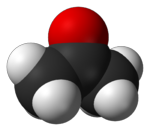ACETONE (C3H6O)
CAS Registry Number : 67-64-1
|
Acetone's chemical shape
|

Structure and dimension's of acetone molecule
|
 |
DESCRIPTION :
Acetone is the organic compound with the formula (CH3)2CO. This colorless, mobile, flammable liquid is the simplest example of the ketones. Owing to the fact that acetone is miscible with water it serves as an important solvent in its own right, typically as the solvent of choice for cleaning purposes in the laboratory. More than 3 million tonnes are produced annually, mainly as a precursor to polymers. Familiar household uses of acetone are as the active ingredient in nail polish remover and as paint thinner and sanitary cleaner/nail polish remover base. It is a common building block in organic chemistry.Acetone is naturally produced and disposed of in the human body as a result of normal metabolic processes. Reproductive toxicity tests show that it has low potential to cause reproductive problems. In fact, the body naturally increases the level of acetone in pregnant women, nursing mothers and children because their higher energy requirements lead to higher levels of acetone production.12 The medical community is now using ketogenic diets that increase acetone in the body to reduce epileptic attacks in infants and children who suffer from recalcitrant refractory epilepsy.
|
|
|
|
|
Hazards |
|
NFPA 704
|
EU Classification
|
Uses:
About half of the world's production of acetone is consumed as a precursor to methyl methacrylate. This application begins with the initial conversion of acetone to its cyanohydrin: |
|
(CH3)2CO + HCN → (CH3)2C(OH)CN
In a subsequent step, the nitrile is hydrolyzed to the unsaturated amide, which is esterified:
(CH3)2C(OH)CN + CH3OH → CH2=(CH3)CCO2CH3 + NH3
The second major use of acetone entails its condensation with phenol to give bisphenol A:
(CH3)2CO + 2 C6H5OH → (CH3)2C(C6H4OH)2 + H2O
Bisphenol-A is a component of many polymers such as polycarbonates, polyurethanes, and epoxy resins.
|
Risk-Phrases : R11, R36, R66, R67
Safety-Phrases : (S2), S9, S16, S26
PDF VERSION





